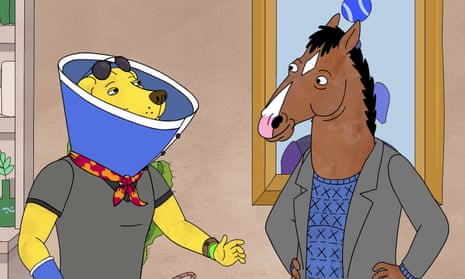Why does BoJack Horseman, titular character of the Netflix originals cartoon comedy series, have to be a horse? This question plays on my mind every time I watch the show.
In the first series we meet BoJack as he’s hit rock bottom: he’s a depressed has-been actor, a self-loathing alcoholic incapable of a real relationship. His only comfort in life is watching re-runs of himself in Horsin’ Around, a bargain basement 1980s sitcom along the lines of Full House.
He’s a stereotypical Hollywood wash-up, complete with dadbod and a doomed romantic interest in a younger woman. But he’s also a horse.
BoJack sounds exactly like a middle-aged white man. He is voiced by Will Arnett, a middle-aged white man. His cultural mores, values and tastes are those of a middle-aged white man. The very premise of the show, BoJack’s midlife crisis, unfolds more or less as it would if he were a middle-aged white man. But, remember, he’s a horse.
This may sound trivial – of course he doesn’t act like a real horse, real horses can’t speak – but if being a horse is just the setup for a couple of gags centred on tail flicks and neighs, and isn’t really an essential part of his character, why not make him a human being?
The creators seemingly feel no need to show how a 50-year-old horse ended up having the same life experiences as a white guy, or why the other characters in the show interact with him on this basis. It’s an odd conceit, known as the “male-as-default” concept in entertainment.
What makes it even more odd is that the creator of the show, Raphael Bob-Waksberg, has shown he understands this trope:
My first gut reaction to the designs was, ‘This feels weird.’ I said to Lisa, ‘I feel like these characters should be guys.’ She said, ‘Why?’ I thought about it for a little bit, realised I didn’t have a good reason, and went back to her and said, ‘You’re right, let’s make them ladies.’
I am embarrassed to admit this conversation has happened between Lisa and me multiple times, about multiple characters.
He goes on to narrate where this knee-jerk response comes from: an ingrained tendency to view femaleness as a moving part that must be consciously dealt with during the writing process. On this score, whiteness works in an identical way. A white character is the default option, from which all other racial identities are perceived to deviate.
By making BoJack white in every respect apart from the visual one (he’s a horse), the show is able to take all the shortcuts that come with not having to consider race a factor in his life. It also functions as a shallow elision of race to BoJack’s keenest audience: young and educated pop culture consumers, the very people who are most likely to analyse the show in identity-political terms.
If he were actually a white guy, rather than a horse, I suspect many more elements of the show would be regarded as problematic.
Take this scene, in which Bojack rants at a group of young, attractive women for, among other things, being young and attractive. Modern pop culture criticism doesn’t usually look too kindly on this sort of aggression from white male characters.
But remember, he’s a horse. If he weren’t, we would likely notice that BoJack is actually a very well fleshed-out Troubled White Man archetype whose destructive behaviour we’re primed to excuse because the show does such a good job of portraying him as a complex individual.
To be clear, I don’t believe the show’s creators made BoJack a horse with these intentions in mind. Lisa Hanawalt, who designs the characters, has an oeuvre that contains many anthropomorphised animals, as well as humans with animal elements.
But you have to wonder whether a more creative world to go with Hanawalt’s animal designs was possible. Because without something a bit deeper to add meaning to the novelty of talking animals, BoJack’s horsiness looks like an extended of that perennial joke: “why the long face?”

